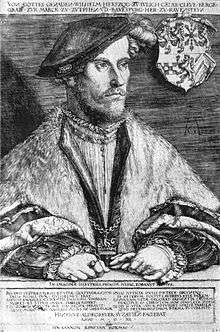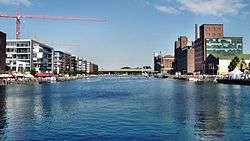University of Duisburg-Essen
| Universität Duisburg-Essen | |
 | |
| Motto | Offen im Denken |
|---|---|
Motto in English | open-minded |
| Type | Public |
| Established | 1654, re-established on 1 January 2003 (1654 see history) |
| Endowment | €426.7 million[1] |
| Chancellor | Rainer Ambrosy |
| Rector | Ulrich Radtke |
Academic staff | 419 (2009) |
Administrative staff | 4,285 |
| Students | 39,153 (2012)[2] |
| Location | Duisburg and Essen, North Rhine-Westphalia, Germany |
| Campus | Urban/Suburban |
| Colours | Blue and White |
| Affiliations | UAMR - University Alliance Metropolis Ruhr,[3] DAAD, DFG, IRUN |
| Website |
www |



The University of Duisburg-Essen (German: Universität Duisburg-Essen) is a public university in Duisburg and Essen, North Rhine-Westphalia, Germany and a member of the newly founded University Alliance Metropolis Ruhr.[4] It was founded in 1654 and re-established on 1 January 2003 as a merger of the Gerhard Mercator University of Duisburg and the University of Essen. Until 1994 the name of the Gerhard Mercator University was Comprehensive University of Duisburg.
With its 12 departments and more than 39,000 students, the University of Duisburg-Essen is among the 10 largest German universities. In the Times Higher Education World University Rankings 2016-17 the University of Duisburg-Essen was ranked 197th in the world and stands at 17th place in it's 150 Under 50 Rankings. In many disciplines the UDE ranks amongst the TOP 10 of German research universities. Over the past three years, research income has risen by 150 percent.[5] Many international students study at the University of Duisburg-Essen and give the cities of Duisburg and Essen an international atmosphere.
History
Origins; The University of Duisburg (1555) Its origins date back to the 1555 decision of Duke Wilhelm V von Jülich-Kleve-Berg to create a university for the unified duchies at the Lower Rhine. To this end, it was necessary to obtain a permission of the emperor and the pope. Although the permission of the pope was granted in 1564 and of the emperor in 1566, the university was founded about ninety years later in 1654, after the acquisition of the duchy of Kleve by Frederick William, Elector of Brandenburg. It opened on 14 October 1655 by Johannes Claudberg as their first rector. The university had four faculties: Theology, Medicine, Law and Arts. During its period of activity it was one of the central and leading universities of the western provinces of Prussia.
Only a few decades later the university was in competition with the much better equipped Dutch universities. Since only about one third of the population in the western provinces of Prussia were member of the reformed church, most Lutheran and Catholic citizens in the second half of the 18th century, sent their sons to other universities.
The university declined rapidly and was on 18 October 1818 due to a Cabinet Order of Friedrich Wilhelm III. officially closed. At the same time, the University of Bonn was founded. Large parts of the Duisburg University Library were relocated to Bonn and then formed the basis of the newly formed Bonn Library. Also the sceptre of the University of Duisburg was given to the University of Bonn, and is available until today.
In 1891 the Rheinisch-Westfälische Hüttenschule was settled from Bochum to Duisburg, which was later developed to the Königlich-Preußischen Maschinenbau- und Hüttenschule, and was renamed in 1938 to Public School of Engineering.
After a decision of the federal state government in 1960 the teacher training college of Kettwig was settled to Duisburg and was named Pedagogical University Ruhr. In 1968, the university was founded again in Duisburg, related to the old one, bearing the name: Comprehensive University of Duisburg. Initially only small, the university was developed rapidly in the 1970s up to about 15,000 students. In 1972 the Pedagogical University Ruhr and the Public School of Engineering, which was renamed in 1971 to University of applied sciences Duisburg. Other schools were also relocated to Duisburg. The University of Duisburg was then called Comprehensive University of Duisburg. In 1994 the university was renamed Gerhard Mercator University.
In 2003, Gerhard Mercator University merged with the University of Essen to form the University of Duisburg-Essen, which is today one of the largest universities in Germany with about 30,000 students.
Recent developments
In 2013 Duisburg-Essen University is ranked number 69 in the World's top 100 universities under 50 years old: ranked by Times Higher Education.
In March 2007 the three universities of Bochum, Dortmund and Duisburg and Essen founded the University Alliance Metropolis Ruhr, which is modelled on the University of California system.
Institutions
The University of Duisburg-Essen today has twelve faculties, listed below:
- Faculty of Humanities
- Faculty of Social Sciences
- Department of Educational Sciences
- Faculty of Art and Design
- Faculty of Business Administration and Economics
- Mercator School of Management - Faculty of Business Administration
- Faculty of Mathematics
- Faculty of Physics
- Department of Chemistry
- Department of Biology and Geography
- Faculty of Engineering
- Faculty of Medicine
Central scientific institutes
- Centre for Nanointegration Duisburg-Essen (CeNIDE)
- German-French Institute for Automation and Robotics (IAR)
- Erwin L. Hahn Institute for Magnetic Resonance Imaging
- Essen College of Gender Studies (EKfG)
- Institute for Experimental Mathematics (IEM)
- Institute for Advanced Study in the Humanities
- Institute of East Asian Studies (IN-EAST)
- Institute for Labor/ Labour and Qualification (IAQ)
- Interdisciplinary center for analytics on the nanoscale (ICAN)[6]
- Centre for Logistics and Transport (ZLV)
- Centre for Medical Biotechnology (ZMB)
- Centre for Water and Environmental Research (ZMU)
- Centre for empirical research in education (ZeB)
Associated institutes
- paluno, The Ruhr Institute for Software Technology
- German Textile Research Centre North-west (DTNW)
- Development Centre for Ship Technology and Transport Systems (DST)
- Asia-Pacific Economic Research Institute (FIP)
- Institute of Energy and Environmental Technology (IUTA)
- Institute for Labor/ Labour and Qualification (IAQ)
- Institute of Mobile and Satellite Communication Technology (IMST)
- Institute for Prevention and Health Promotion (IPG)
- Institute of Science and Ethics (IWE)
- IWW Water Centre (IWW)
- Rhine-Ruhr Institute for Social Research and Political Consulting (RISP)
- Salomon Ludwig Steinheim Institute for German-Jewish History (StI)
- Centre for Fuel Cell Technology (ZBT)
Mercator-Professorship Award
The University of Duisburg-Essen awards the Mercator-Professur to individuals who are well known for their social and scientific engagement. So far, recipients of the Mercator-Professur have been:
- 1997: Hans-Dietrich Genscher, politician (FDP), former Foreign Minister and Vice Chancellor of the Federal Republic of Germany
- 1998: Siegfried Lenz, writer
- 1999: Jan Philipp Reemtsma, literary scholar.
- 2000: Jutta Limbach, jurist and politician (SPD)
- 2001: Volker Schlöndorff, filmmaker.
- 2002: Ulrich Wickert, journalist, chief anchor for tagesthemen
- 2003: Daniel Goeudevert French writer, management consultant.
- 2004: Walter Kempowski, writer.
- 2005: Richard von Weizsäcker, politician (CDU), former President of the Federal Republic of Germany.
- 2006: Necla Kelek, social scientist
- 2007: Hanan Ashrawi, legislator, activist, and scholar
- 2008: Christiane Nüsslein-Volhard, biologist, winner of the Nobel Prize in Physiology or Medicine
- 2009: Peter Scholl-Latour, journalist and publicist
- 2010: Alice Schwarzer, publisher and feminist
- 2011: Udo Di Fabio, former judge of the Federal Constitutional Court
- 2012: Wolfgang Huber, Bishop, former Chairman of the Council of the EKD
Professors include Jette Joop, Kai Krause and Bruce Ames.
Points of interest
- Botanischer Garten der Universität Duisburg-Essen, the university's botanical garden in Essen
See also
References
- ↑
- ↑
- ↑ http://www.ua-ruhr.de/index_en.htm
- ↑ http://www.ua-ruhr.de/index_en.htm
- ↑ https://www.timeshighereducation.com/world-university-rankings/universitat-duisburg-essen#ranking-dataset/589595
- ↑ "https://www.uni-due.de/cenide/ican/index_en". Retrieved 2016-10-20. External link in
|title=(help)
Further reading
- 30 Jahre Universität Essen (Essener Universitätsreden, Heft 10, Akademisches Jahr 2001/02), Universität Essen 2002 (Beiträge aus der Vortragsreihe „Wurzeln der Universität“)
- Claus Bussmann, Holger Heith: Chronik 1972-1997. Chronik der ersten 25 Lebensjahre der Gerhard-Mercator-Universität/GH Duisburg, die als Gesamthochschule Duisburg das Licht der Welt erblickte, Duisburg 1997, ISBN 3-00-001433-0
- Dieter Geuenich, Irmgard Hantsche (Hrsg.): Zur Geschichte der Universität Duisburg 1655-1818 (Duisburger Forschungen 53), Duisburg 2007
- Helmut Schrey: Die Universität Duisburg. Geschichte und Gegenwart. Traditionen, Personen, Probleme, Duisburg 1982, ISBN 3-87096-166-X
External links
| Wikimedia Commons has media related to Universität Duisburg-Essen. |
- Official website of the University of Duisburg-Essen (English)
- Official website of the University of Duisburg-Essen (German)
- University of Duisburg-Essen Academic Liaison Office, USA (English)
- UAMR - University Alliance Metropolis Ruhr (English)
Coordinates: 51°27′50″N 7°00′22″E / 51.46389°N 7.00611°E